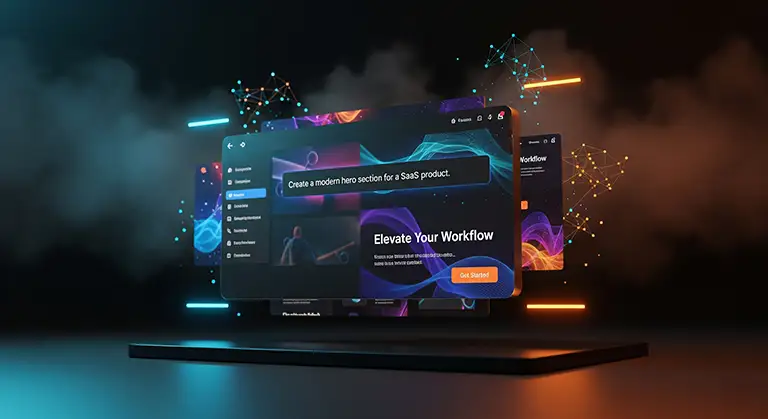The website of tomorrow won’t be built—it will be born—prompted into existence, personalized for every visitor, and optimized by an intelligence that never sleeps. This isn’t sci-fi. It’s the immediate AI web design future—and teams that adapt now will outrun the market.
Why This Matters Now (Fast Read)
- Compress build cycles from weeks to days with prompt-to-UI and AI coding agents.
- Shift from one-size-fits-all to each-visitor-unique experiences.
- Turn analytics into automated, on-page improvements.
- Give small teams enterprise-grade QA and security without enterprise headcount.
If you’re new here, warm up with Large Language Models 101
The AI Revolution: From Helper → Collaborator
AI is no longer autocomplete. Today’s stack ideates layouts, drafts copy, proposes flows, writes tests, scans for vulnerabilities, and opens pull requests. Think in three coordinated roles:
- Creator — Generates UI, copy, images, and working code from prompts.
- Optimizer — Spots friction, runs experiments, and ships improvements.
- Personalizer — Tailors messages, layouts, and offers in real time.
What Changes for Your Team
- Time-to-value drops: v1 ships in hours, not weeks.
- Throughput rises: test 10 ideas per week instead of one.
- Quality improves: automated tests, security scans, and intelligent reviews guard every merge.
The Future of Web Design: Predictive, Personal, Prompt-Driven

Generative UI/UX (Prompt → Page)
Describe the page you want—AI returns a responsive structure with sound hierarchy, content stubs, and component suggestions. Expect:
- Production-ready sections (hero, pricing, FAQs) that you can restyle quickly
- Automatic alt text, semantic headings, and accessible contrast checks
- Reusable components you can version across pages and brands
Implementation tip: Start every new page with a prompted wireframe. Lock brand tokens (color/typography/spacing) before visual polish.
Hyper-Personalization (Beyond A/B)
Stop designing for an “average” user. Craft adaptive interfaces that respond to:
- Behavior: scroll depth, route history, repeat visits, and session intent
- Context: device, referrer, geolocation, and time of day
- Declared data: industry, goals, budget range, or content preferences
Governance tip: Maintain a Personalization Playbook: trigger → segment → variation → guardrails → KPI. Start with on-site signals and explicit user preferences to stay privacy-first.
AI-Powered Analytics That Take Action
Heatmaps, session replays, and funnel drop-offs become AI-summarized opportunities:
“Fix mobile spacing on pricing cards; users rage-click the ‘Compare plans’ toggle.” Pair this with automated rollouts once models hit lift confidence.
The Future of Web Development: Autonomous, Efficient, Self-Healing

AI Pair Programming Becomes Table Stakes
Coding assistants now refactor functions, translate frameworks, surface docs inline, and propose PRs. Result: faster commits, cleaner diffs, and humans focused on product logic—not boilerplate. Deeper dive: AI-Powered Coding: How Large Language Models Are Reshaping Software Development.
Automated Testing & Debugging
Agents generate unit/integration tests from user stories, reproduce bugs from traces, and propose fixes. Your CI pipeline sees fewer regressions and faster feedback loops.
Security Shift-Left
IDE scanners and autofix meet policy-as-code. Add pre-commit hooks, repo rules, and protected branches. Every generated line passes the same gates as human code.
Generative Backends & Infra
Prompts scaffold routes, schemas, and data layers. Infra-as-code becomes conversational while staying versioned. Governance stays human—automation handles the heavy lifting.
How to Harness This Future Today: Practical Tooling Map (2025)
Pick one from each layer to start; add depth over time.
A) AI Website Builders (Launch Speed)
Great for quick, credible sites: local services, landing pages, event microsites.
Use for: brand-new properties, campaign pages, MVP validation.
Popular picks: Wix AI Website Builder, Hostinger AI Website Builder, WordPress.com AI Site Builder.
B) AI Design Assistants (Brand Depth)
Control components, tokens, and interactions; export to code or Figma.
Use for: pattern libraries, product marketing, iterative UX sprints.
Popular picks: Framer (AI + Wireframer + Workshop), Khroma (palette), Galileo-style prompt-to-UI tools.
C) AI Development Accelerators (Production Scale)
Code generation, reviews, security scans, test creation, and CI alignment.
Use for: apps with auth, dashboards, pricing logic, or multi-integration complexity.
Popular picks: GitHub Copilot (with Autofix/agents), Amazon Q Developer, Cursor, Vercel v0 + AI SDK.
In-Depth Comparison: Best AI Platforms for Web & Design (2025)
Choose by outcome: launch fast (builders), control polish (design assistants), govern quality (dev accelerators).
| Tool | Category | Best For | Core Benefits | Notes |
|---|---|---|---|---|
| Wix AI Website Builder | Builder | All-in-one SMB sites | Conversational site creation, rich templates, AI text/media, built-in marketing | “Site + marketing” ecosystem |
| Hostinger AI Website Builder | Builder | Lowest friction to publish | 1-minute site gen, basic ecommerce add-ons, simple editor | Great value for quick launches |
| WordPress.com AI Site Builder | Builder | Content-heavy sites | Prompted layouts, block editor, plugin ecosystem | Smooth path to full WordPress control |
| Framer (AI, Wireframer, Workshop) | Design/Builder | Visual control + speed | Prompt-to-page, responsive breakpoints, component Workshop | Designer-loved; responsive by default |
| Prompt-to-UI (Galileo-style) | Design | Rapid UI ideation | Text-to-UI mockups, multiple variants, export to Figma/code | Ideal for concepts & flows |
| Khroma | Design Utility | Brand palettes | AI-personalized color systems | Useful for design tokens |
| GitHub Copilot (+ Autofix/Agents) | Dev Accelerator | Pro/dev teams | Code gen, bug-fix agents, PR assistance, vulnerability autofix | Deep IDE + GitHub integration |
| Amazon Q Developer | Dev Accelerator | AWS-centric teams | Chat/agents, code review, security scanning, upgrade automation | Strong shift-left security |
| Cursor | Dev Accelerator | Power users & startups | Editor + agents (background, bugbot), long context windows | Fast iteration environment |
| Vercel v0 + AI SDK | Gen-UI/Frontend | React/Next.js teams | Prompt-to-components, live UI streaming from LLMs | Best with Vercel deploys |
Pro tip: Validate messaging with a builder in a day. As you scale, migrate components into a design system, then enforce quality with a dev accelerator (tests, security, CI).
Recommendations by Role
Business Owners & Marketing Managers
- Ship v1 fast with Wix or Hostinger; connect domain, analytics, and forms on day one.
- Add behavior insights (session recordings + heatmaps). Run one experiment/week: headline, social proof, pricing layout, CTA microcopy.
- Document a Personalization Playbook with triggers, segments, variants, guardrails, and KPIs.
- Graduate to Framer or WordPress when you need more brand control.
Designers & Content Teams
- Use prompt-to-wireframe to skip blank-canvas paralysis; lock tokens early.
- Maintain a component shelf (hero, navs, pricing, FAQs, testimonials) and track reuse.
- Pair Khroma with accessibility checks to guarantee contrast.
- Measure design impact: adoption rate, time-to-ship, and design-led conversion lift.
Developers & Product Teams
- Standardize on a coding assistant (Copilot or Amazon Q Developer).
- Treat AI code like any PR: tests, coverage thresholds, linters, required review.
- Prototype with Vercel v0 (or similar), then fold components into your design system.
- Turn on autofix and security scanning in CI; protect branches and keep audit logs.
Implementation Playbook (Step-by-Step)
- Day 0 (2 hours): Define outcomes—leads, demo requests, CAC/LTV, conversion lift, page speed, content velocity.
- Day 1 (half-day): Pick one builder, one design assistant, one dev accelerator, and one analytics suite. Draft a privacy-first data plan.
- Day 1–2: Prompt to site, connect domain, install analytics + session insights, and publish.
- Week 1: Run 3 micro-tests (headline, hero image, CTA). Use AI summaries; ship the winner.
- Week 2: Personalize one element (hero subtitle or social proof) for a high-value segment.
- Week 3: Add tests and CI policies; enable code scanning and autofix.
- Week 4+: Fold repeated sections into a component library; track reuse, time saved, and conversion lift.
Risks & Mitigations (Read Before You Ship)
- Hallucinations & subtle bugs → Keep humans in the loop. Gate merges with CI, tests, and linters.
- Security exposure → Least-privilege for integrations, repo protection, IDE scanning, and autofix in PRs.
- Data leakage → Segment private data, redact prompts/logs, prefer BYOK/private endpoints when needed.
- SEO pitfalls → Thin, generic AI copy tanks rankings. Add expert commentary, evidence, and original media. Use internal links to clarify context and intent.
Conclusion
AI is no longer “nice to have.” It’s the operating system of modern web design and development—compressing timelines, amplifying creativity, and lifting conversion with experiences tailored to each visitor. Choosing a tool is the first step. Building a repeatable, secure system with it is how you win.
Let’s build it together. MaxtDesign integrates AI across design, development, and growth so your team ships faster—and smarter.
Frequently Asked Questions
No. The strongest results come from pairing human judgment with AI leverage. Designers set direction; developers harden systems; AI accelerates both.
Pick one builder (Wix, Hostinger, or WordPress.com AI), one analytics tool, and ship v1 this week. Iterate weekly using behavior insights and AI-assisted tweaks.
Security, privacy, and quality drift. Use human review, automated tests, model controls, and least-privilege access. Keep a changelog of AI-assisted edits.
It can be—if you treat it like any contribution: scan, test, and review; enable autofix and policy checks; protect branches.
Builders that slash time-to-first-value (Wix, Hostinger, WordPress.com AI) + behavior analytics (Fullstory/Hotjar) + one coding assistant (Copilot or Amazon Q Developer).
Yes. Start with on-site behavior and declared preferences; avoid opaque data brokers. Explain value and offer controls.
Blend AI drafts with expert commentary, customer proof, and original visuals. Maintain E-E-A-T and link to relevant internal resources.
Fact Bank:
- Generative AI is estimated to contribute trillions in annual value globally (with software, marketing, and customer operations among the biggest beneficiaries).
- Controlled studies show AI pair programming can make developers ~50%+ faster on certain tasks.
- Developer surveys indicate most professionals now use or plan to use AI tools at work.
- Generative UI tools can produce React components or full pages from natural-language prompts.
- Major AI website builders (Wix, Hostinger, WordPress.com AI) can generate a functional site in minutes, then allow human editing.
- Behavior analytics + AI compress the loop from “insight” to “live test,” enabling weekly experimentation.
- Shift-left security with IDE scanning and autofix reduces vulnerabilities sneaking into main branches.

